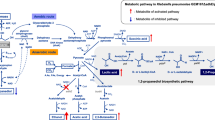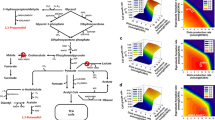Abstract
K. pneumoniae BLh-1 strain was genetically modified aiming at obtaining high ethanol productivity in cultivations using residual glycerol from biodiesel synthesis as substrate. The recombinant strain K. pneumoniae Kp17 was obtained by inserting the multicopy plasmid pTOPOBL17 containing the AdhE gene, and its own promoter, from K. pneumoniae BLh-1. Influence of Fe2+ supplementation and initial glycerol concentration on culture conditions were analyzed, both in rotatory shaker and in batch bioreactors. In the bioreactor cultures, K. pneumoniae Kp17 strain produced 4.5 g L−1 of ethanol (productivity of 0.50 g L−1 h−1 and yields of 0.15 g g−1) after 24-h cultivation, corresponding to an increase of approximately 40% in ethanol concentration compared to wild strain, K. pneumoniae BLh-1. Best conditions were then applied in exponential fed-batch bioreactors, with final ethanol concentration of 17.30 g L−1 (productivity of 0.59 g L−1 h−1 and yields of 0.16 g g−1) after 30 h of feeding, representing 11.5% of increment in titer of ethanol compared to the wild strain. Mutant cells kept 92.5% of the plasmids under batch in 24 h, and 71.9% under fed-batch after 27 h of exponential feeding. The findings in this work show the possibility of using a simple approach to genetically modify K. pneumoniae to be employed this versatile bacterium for the bioconversion of residual glycerol into ethanol.




Similar content being viewed by others
References
Anuar, M. R., & Abdullah, A. Z. (2016). Challenges in biodiesel industry with regards to feedstock, environmental, social and sustainability issues: A critical review. Renewable and Sustainable Energy Reviews, 58, 208–223. https://doi.org/10.1016/j.rser.2015.12.296.
Liew, F., Henstra, A. M., Kӧpke, M., Winzer, K., Simpson, S. D., & Minton, N. P. (2017). Metabolic engineering of Clostridium autoethanogenum for selective alcohol production. Metabolic Engineering, 40(January), 104–114. https://doi.org/10.1016/j.ymben.2017.01.007.
Veluturla, S., Archna, N., Subba Rao, D., Hezil, N., Indraja, I. S., & Spoorthi, S. (2018). Catalytic valorization of raw glycerol derived from biodiesel: a review. Biofuels, 9(3), 305–314. https://doi.org/10.1080/17597269.2016.1266234.
Russmayer, H., Egermeier, M., Kalemasi, D., & Sauer, M. (2019). Spotlight on biodiversity of microbial cell factories for glycerol conversion. Biotechnology Advances, 37(6), 107395. https://doi.org/10.1016/j.biotechadv.2019.05.001.
Garlapati, V. K., Shankar, U., & Budhiraja, A. (2016). Bioconversion technologies of crude glycerol to value added industrial products. Biotechnology Reports, 9, 9–14. https://doi.org/10.1016/j.btre.2015.11.002.
Monteiro, M. R., Kugelmeier, C. L., Pinheiro, R. S., Batalha, M. O., & da Silva César, A. (2018). Glycerol from biodiesel production: Technological paths for sustainability. Renewable and Sustainable Energy Reviews, 88(February), 109–122. https://doi.org/10.1016/j.rser.2018.02.019.
Sunarno, J. N., Prasertsan, P., Duangsuwan, W., Cheirsilp, B., & Sangkharak, K. (2019). Biodiesel derived crude glycerol and tuna condensate as an alternative low-cost fermentation medium for ethanol production by Enterobacter aerogenes. Industrial Crops and Products, 138(June), 1–8. https://doi.org/10.1016/j.indcrop.2019.06.014.
Luo, X., Ge, X., Cui, S., & Li, Y. (2016). Value-added processing of crude glycerol into chemicals and polymers. Bioresource Technology, 215, 144–154. https://doi.org/10.1016/j.biortech.2016.03.042.
Lari, G. M., Pastore, G., Haus, M., Ding, Y., Papadokonstantakis, S., Mondelli, C., & Pérez-Ramírez, J. (2018). Environmental and economical perspectives of a glycerol biorefinery. Energy and Environmental Science, 11(5), 1012–1029. https://doi.org/10.1039/c7ee03116e.
Rhie, M. N., Kim, H. T., Jo, S. Y., Chu, L. L., Baritugo, K. A., Baylon, M. G., Lee, J., Na, J. G., Kim, L. H., Kim, T. W., Park, C., Hong, S. H., Joo, J. C., & Park, S. J. (2019). Recent advances in the metabolic engineering of Klebsiella pneumoniae: A potential platform microorganism for biorefineries. Biotechnology and Bioprocess Engineering, 24(1), 48–64. https://doi.org/10.1007/s12257-018-0346-x.
Posada, J. a., & Cardona, C. a. (2010). Design and analysis of fuel ethanol production from raw glycerol. Energy, 35(12), 5286–5293. https://doi.org/10.1016/j.energy.2010.07.036.
Kumar, V., & Park, S. (2017). Potential and limitations of Klebsiella pneumoniae as a microbial cell factory utilizing glycerol as the carbon source. Biotechnology Advances, 36(1), 150–167. https://doi.org/10.1016/j.biotechadv.2017.10.004.
Zhao, Y., Damgaard, A., & Christensen, T. H. (2018). Bioethanol from corn Stover À a review and technical assessment of alternative biotechnologies. Progress in Energy and Combustion Science, 67, 275–291. https://doi.org/10.1016/j.pecs.2018.03.004.
Johnson, D., & Taconi, K. (2007). The glycerin glut: Options for the value-added conversion of crude glycerol resulting from biodiesel production. Environmental Progress, 26(4), 338–348. https://doi.org/10.1002/ep.10225.
Ahrens, K., Menzel, K., Zeng, A. P., & Deckwer, W. D. (1998). Kinetic, dynamic, and pathway studies of glycerol metabolism by Klebsiella pneumoniae in anaerobic continuous culture: III. Enzymes and fluxes of glycerol dissimilation and 1,3-propanediol formation. Biotechnology and Bioengineering, 59(5), 544–552. https://doi.org/10.1002/(SICI)1097-0290(19980905)59:5<544::AID-BIT3>3.0.CO;2-A.
Celinska, E. (2010). Debottlenecking the 1,3-propanediol pathway by metabolic engineering, 28, 519–530. https://doi.org/10.1016/j.biotechadv.2010.03.003.
Menzel, K., & Zeng, a P., Biebl, H., & Deckwer, W. D. (1996). Kinetic, dynamic, and pathway studies of glycerol metabolism by Klebsiella pneumoniae in anaerobic continuous culture: I. The phenomena and characterization of oscillation and hysteresis. Biotechnology and Bioengineering, 52(5), 549–560. https://doi.org/10.1002/(SICI)1097-0290(19961205)52:5<549::AID-BIT2>3.0.CO;2-J.
Nikel, P. I., Ramirez, M. C., Pettinari, M. J., Méndez, B. S., & Galvagno, M. a. (2010). Ethanol synthesis from glycerol by Escherichia coli redox mutants expressing adhE from Leuconostoc mesenteroides. Journal of Applied Microbiology, 109(2), 492–504. https://doi.org/10.1111/j.1365-2672.2010.04668.x.
Oh, B.-R., Seo, J.-W., Heo, S.-Y., Hong, W.-K., Luo, L. H., Kim, S., Kwon, O., Sohn, J. H., Joe, M. H., Park, D. H., & Kim, C. H. (2012). Enhancement of ethanol production from glycerol in a Klebsiella pneumoniae mutant strain by the inactivation of lactate dehydrogenase. Process Biochemistry, 47(1), 156–159. https://doi.org/10.1016/j.procbio.2011.10.011.
Guo, X., Cao, C., Wang, Y., Li, C., Wu, M., Chen, Y., Zhang, C., Pei, H., & Xiao, D. (2014). Effect of the inactivation of lactate dehydrogenase, ethanol dehydrogenase, and phosphotransacetylase on 2,3-butanediol production in Klebsiella pneumoniae strain. Biotechnology for Biofuels, 7(1), 44. https://doi.org/10.1186/1754-6834-7-44.
Oh, B.-R., Seo, J.-W., Heo, S.-Y., Hong, W.-K., Luo, L. H., Joe, M., Park, D. H., & Kim, C. H. (2011). Efficient production of ethanol from crude glycerol by a Klebsiella pneumoniae mutant strain. Bioresource Technology, 102(4), 3918–3922. https://doi.org/10.1016/j.biortech.2010.12.007.
Shams Yazdani, S., & Gonzalez, R. (2008). Engineering Escherichia coli for the efficient conversion of glycerol to ethanol and co-products. Metabolic Engineering, 10(6), 340–351. https://doi.org/10.1016/j.ymben.2008.08.005.
Oh, B. R., Hong, W. K., Heo, S. Y., Joe, M. H., Seo, J. W., & Kim, C. H. (2013). The role of aldehyde/alcohol dehydrogenase (AdhE) in ethanol production from glycerol by Klebsiella pneumoniae. Journal of Industrial Microbiology and Biotechnology, 40(2), 227–233. https://doi.org/10.1007/s10295-012-1224-8.
Morcelli, A., Rech, R., Klafke, A., Pelegrini, R., & Ayub, M. A. Z. (2018). Exponential fed-batch cultures of klebsiella pneumoniae under anaerobiosis using raw glycerol as a substrate to obtain value-added bioproducts. Journal of the Brazilian Chemical Society, 29(11), 2278–2286. https://doi.org/10.21577/0103-5053.20180104.
Rossi, D. M., da Costa, J. B., de Souza, E. A., Peralba, M. D. C. R., & Ayub, M. A. Z. (2012). Bioconversion of residual glycerol from biodiesel synthesis into 1,3-propanediol and ethanol by isolated bacteria from environmental consortia. Renewable Energy, 39(1), 223–227. https://doi.org/10.1016/j.renene.2011.08.005.
Green, M. R., & Sambrook, J. (2012). Molecular Cloning. Molecular Cloning: A Laboratory Manual (4th ed., Vol. 2). New York: Cold Spring Harbor.
Rossi, D. M., Souza, E. A. De, & Ayub, M. A. Z. (2013). Biodiesel residual glycerol metabolism by Klebsiella pneumoniae: pool of metabolites under anaerobiosis and oxygen limitation as a function of feeding rates, 1952–1964. https://doi.org/10.1007/s12010-013-0114-5,
Tomazetto, G., Mulinari, F., Stanisçuaski, F., Settembrini, B., Carlini, C. R., & Ayub, M. A. Z. (2007). Expression kinetics and plasmid stability of recombinant E. coli encoding urease-derived peptide with bioinsecticide activity. Enzyme and Microbial Technology, 41(6-7), 821–827. https://doi.org/10.1016/j.enzmictec.2007.07.006.
Weber, A. E., & San, K.-Y. (1989). A comparison of two plating techniques to estimate plasmid stability of a prolonged chemostat culture. Biotechnology Techniques, 3(6), 397–400.
Wang, X., & Sa, N. (2013). Engineered constitutive pathway in Klebsiella pneumoniae for 3-hydroxypropionic acid production and implications for decoupling glycerol dissimilation pathways, 293–299. https://doi.org/10.1007/s00284-012-0271-8,.
Kessler, D., Herth, W., & Knappe, J. (1992). Ultrastructure and pyruvate formate-lyase radical quenching property of the multienzymic AdhE protein of Escherichia coli *. The Journal of Biological Chemistry, 267(25), 18073–18079.
Zeng, A.-P., Menzel, K., & Deckwer, W. D. (1996). Kinetic, dynamic, and pathway studies of glycerol metabolism by Klebsiella pneumoniae in anaerobic continuous culture: II. Analysis of metabolic rates and pathways under oscillation and steady-state conditions. Biotechnology and Bioengineering, 52(5), 561–571. https://doi.org/10.1002/(SICI)1097-0290(19961205)52:5<561::AID-BIT3>3.0.CO;2-H.
Zeng, A. P., Biebl, H., Schlieker, H., & Deckwer, W. D. (1993). Pathway analysis of glycerol fermentation by Klebsiella pneumoniae: Regulation of reducing equivalent balance and product formation. Enzyme and Microbial Technology, 15(9), 770–779. https://doi.org/10.1016/0141-0229(93)90008-P.
Wu, K.-J., Saratale, G. D., Lo, Y.-C., Chen, W.-M., Tseng, Z.-J., Chang, M.-C., Tsai, B. C., Su, A., & Chang, J.-S. (2008). Simultaneous production of 2,3-butanediol, ethanol and hydrogen with a Klebsiella sp. strain isolated from sewage sludge. Bioresource Technology, 99(17), 7966–7970. https://doi.org/10.1016/j.biortech.2008.03.062.
Zeng, A.-P., Ross, A., Biebl, H., Tag, C., Gunzel, B., & Deckwer, W.-D. (1994). Multiple product inhibition and growth modeling of Clostridium butyricum and Klebsiella pneumoniae in glycerol fermentation, 44.
Cheng, K., Liu, H., & Liu, D. (2005). Multiple growth inhibition of Klebsiella pneumoniae in 1 , 3-propanediol fermentation, 19–22.
Metsoviti, M., Paraskevaidi, K., Koutinas, A., Zeng, A., & Papanikolaou, S. (2012). Production of 1,3-propanediol, 2,3-butanediol and ethanol by a newly isolated Klebsiella oxytoca strain growing on biodiesel-derived glycerol based media. Process Biochemistry, 47(12), 1872–1882. https://doi.org/10.1016/j.procbio.2012.06.011,.
Menzel, K., Ahrens, K., Zeng, A. P., & Deckwer, W. D. (1998). Kinetic, dynamic, and pathway studies of glycerol metabolism by Klebsiella pneumoniae in anaerobic continuous culture: IV. Enzymes and fuxes of piruvate metabolism. Biotechnology and bioengineering, 60(5), 617–626.
Zong, H., Liu, X., Chen, W., Zhuge, B., & Sun, J. (2017). Construction of glycerol synthesis pathway in Klebsiella pneumoniae for bioconversion of glucose into 1,3-propanediol. Biotechnology and Bioprocess Engineering, 22(5), 549–555. https://doi.org/10.1007/s12257-016-0375-2.
Wein, T., Hülter, N. F., Mizrahi, I., & Dagan, T. (2019). Emergence of plasmid stability under non-selective conditions maintains antibiotic resistance. Nature Communications, 10(1), 1–13. https://doi.org/10.1038/s41467-019-10600-7.
Fakruddin, M., Mazumdar, R. M., Bin Mannan, K. S., Chowdhury, A., & Hossain, N. M. (2013). Critical factors affecting the success of cloning, expression, and mass production of enzymes by recombinant E. coli, 2013(3).
Gupta, R., Sharma, P., & Vyas, V. V. (1995). Effect of growth environment on the stability of a recombinant shuttle plasmid , pCPPS-31 , in Escherichia coli, 41, 29–37.
Zheng, P., Wereath, K., Sun, J., Heuvel, J. Van Den, & Zeng, A. (2006). Overexpression of genes of the dha regulon and its effects on cell growth, glycerol fermentation to 1,3-propanediol and plasmid stability in Klebsiella pneumoniae, 41, 2160–2169. https://doi.org/10.1016/j.procbio.2006.06.012.
Peng, H., Wu, G., & Shao, W. (2008). The aldehyde/alcohol dehydrogenase (AdhE) in relation to the ethanol formation in Thermoanaerobacter ethanolicus JW200. Anaerobe, 14(2), 125–127. https://doi.org/10.1016/j.anaerobe.2007.09.004.
Fritsche, U. R., Sims, R. E. H., & Monti, A. (2010). Direct and indirect land-use competition issues for energy crops and their sustainable production – An overview, 692–704. https://doi.org/10.1002/bbb.
Valentine, J., Clifton-brown, J., Hastings, A., & Robson, P. (2012). Food vs . fuel : the use of land for lignocellulosic ‘ next generation ’ energy crops that minimize competition with primary food production, 2008, 1–19. https://doi.org/10.1111/j.1757-1707.2011.01111.x.
Manochio, C., Andrade, B. R., Rodriguez, R. P., & Moraes, B. S. (2017). Ethanol from biomass: a comparative overview, 80(November 2016), 743–755. https://doi.org/10.1016/j.rser.2017.05.063.
Zhang, Y., Li, Y., Du, C., Liu, M., & Cao, Z. (2006). Inactivation of aldehyde dehydrogenase: a key factor for engineering 1, 3-propanediol production by Klebsiella pneumoniae. Metabolic Engineering, 8(6), 578–586. https://doi.org/10.1016/j.ymben.2006.05.008.
Acknowledgments
This work was supported by grants from the Conselho Nacional de Desenvolvimento Científico e Tecnológico (CNPq, Brazil) and from the Fundação de Amparo à Pesquisa do Estado do Rio Grande do Sul (FAPERGS, RS). Scholarships were also provided by Coordenação de Aperfeiçoamento de Pessoal de Nível Superior (CAPES, Finance Code 001).
Author information
Authors and Affiliations
Corresponding author
Ethics declarations
Conflict of Interest
The authors declare that they have no conflicts of interest.
Research Involving Human Participants and/or Animals
This work does not involve experiments using humans or other animals.
Informed Consent
Not applicable to this work.
Additional information
Publisher’s Note
Springer Nature remains neutral with regard to jurisdictional claims in published maps and institutional affiliations.
Electronic supplementary material
ESM 1
(DOCX 16 kb)
Rights and permissions
About this article
Cite this article
da Silva, V.Z., Ourique, L.J., de David, C. et al. Construction of Recombinant Klebsiella pneumoniae to Increase Ethanol Production on Residual Glycerol Fed-Batch Cultivations. Appl Biochem Biotechnol 192, 1147–1162 (2020). https://doi.org/10.1007/s12010-020-03397-5
Received:
Accepted:
Published:
Issue Date:
DOI: https://doi.org/10.1007/s12010-020-03397-5




